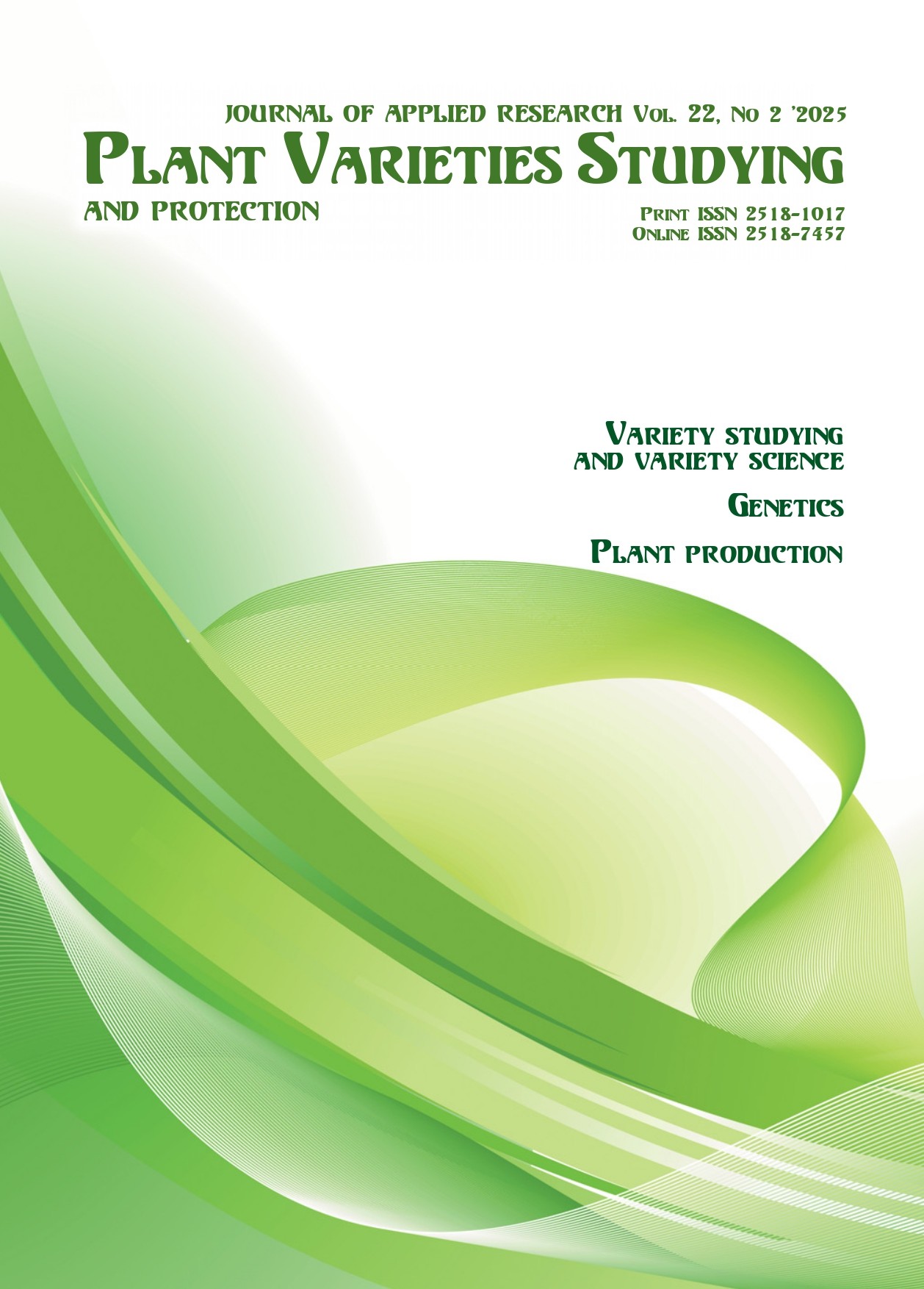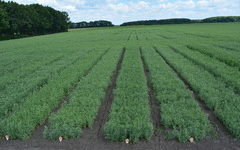The intensity of willow vegetative mass regrowth depending on varietal characteristics, type of planting material, and storage conditions
DOI:
https://doi.org/10.21498/2518-1017.21.2.2025.337839Keywords:
energy willow, biometric indicators, planting material, vegetative massAbstract
Purpose. To establish the characteristics of regrowth of the above-ground mass of the basket willow and almond willow after harvesting, depending on varietal characteristics, type of planting material, and the use of nitrogen fertilizers. In particular, to determine the height of shoots, their diameter and number, as well as the leave area. Methods. The study was conducted in the experimental field of the Institute of Bioenergy Crops and Sugar Beet of the National Academy of Agrarian Sciences of Ukraine in Ksaverivka village, Bila Tserkva district, Kyiv region, from 2023 to 2024. It examined the regrowth characteristics of two types of energy willow (‘Panfylska’ variety of the almond willow and ‘Zbruch’ variety of the basket willow) in the second cycle after harvesting the shoots. Experiments were set up in 2020 using cuttings stored in various ways. Harvesting took place in 2023, after three years of vegetation and before sap flow began. The height and diameter of the shoots were measured from May until the end of the growing season, on the same date each month. Results. The stems of plants obtained from the shoots of the basket willow were found to have a significantly higher regrowth intensity than those of the almond willow. The ‘Zbruch’ variety (with fertilisers) was distinguished by its maximum height in the first year after harvesting. Conclusions. The best stem height and diameter indicators in the second growing cycle after harvesting were recorded in plants obtained from the shoots of the ‘Zbruch’ variety of energy willow. These shoots were stored in containers and their cuts were treated with lime.
Downloads
References
Katelevskyi, V. M. (2020). Giant miscanthus yield in the Forest-Steppe of Ukraine under new cultivation practices. Scientific Papers of the Institute of Bioenergy Crops and Sugar Beet, 28, 221–229. https://doi.org/10.47414/np.28.2020.244149 [In Ukrainian]
Zhang, H., Zhang, Z., Qi, X., Yu, J., Cai, J., & Yang, Z. (2019). Manganese Monoxide/Biomass-Inherited Porous Carbon Nanostructure Composite Based on the High Water-Absorbent Agaric for Asymmetric Supercapacitor. ACS Sustainable Chemistry and Engineering, 7(4), 4284–4294. https://doi.org/10.1021/acssuschemeng.8b06049

Krzyżaniak, M., Stolarski, M. J., Szczukowski, S., Tworkowski, J., Bieniek, A., & Mleczek, M. (2015). Willow biomass obtained from different soils as a feedstock for energy. Industrial Crops and Products, 75, 114–121. https://doi.org/10.1016/j.indcrop.2015.06.030

El Bassam, N. (2010). Handbook of Bioenergy Crops: A Complete Reference to Species, Development and Applications. Routledge. https://doi.org/10.4324/9781849774789
Fuchylo, Ya. D. (2011). Plantation Forestry: Theory, Practice, Prospects. Lohos. [In Ukrainian]
Roik, M. V., Humentyk, M. Ya., & Mamaisur, V. V. (2013). Prospects for Growing Energy Willow for Solid Biofuel Production. Bioenergy, 2, 18–19. [In Ukrainian]
Caslin, B., Finnan, J., & McCracken, A. (Eds.). (2012). Willow Varietal Identification Guide. Teagasc. https://teagasc.ie/wp-content/uploads/media/website/publications/2012/Willow_Identification_Guide_2012.pdf
Oliinyk, Ye., & Yelovikova, T. (2007). Cultivation of Energy Plantations. Ahrosektor, 7–8, 21–22. [In Ukrainian]
Roik, M. V., Sinchenko, V. M., Fuchylo, Ya. D., Humentyk, M. Ya., Hnap, I. V., Zaimenko, N. V., Rakhmetov, D. B., Kurylo, V. L., Furman, V. A., Makukh, Ya. P., Ivanina, V. V., Sliusar, I. T., Kalenska, S. M., Sabluk, V. T., Hryshchenko, O. M., Hanzhenko, O. M., Tanchyk, S. P., Balahura, O. V., Buzynnyi, M. V., … Melnychuk, H. A. (2015). Energy Willow: Cultivation Technology and Application. Nilan-LTD. https://doi.org/10.47414/978-966-924-087-3 [In Ukrainian]
Fuchylo, Ya. D., Zelinskyi, B. V., Ivaniuk, I. D., & Zelinska, L. H. (2023). Cultivation of energy willow plantations on marginal lands of Kyiv Polissia. NOVOhrad. [In Ukrainian]
Fuchylo, Ya. D., Sinchenko, V. M., & Humentyk, M. Ya. (2016). Specifics of growing energy willow. Bioenergy, 1, 11–13. [In Ukrainian]
Sinchenko, V. M., & Melnychuk, H. A. (2018). Economic efficiency of growing energy willow in Ukraine. Bioenergy, 1, 41–45. [In Ukrainian]
Verwijst T., Nordh N.-E. The effects of first-year shoot cut back on willow biomass production during the first and second cutting cycle. Stockholm, 2010. 26 s. URL: https://www.osti.gov/etdeweb/servlets/purl/981897
Karlen D. L., Volk T. A., Abrahamson L. P. et al. Development and Deployment of Willow Biomass Crops. Cellulosic Energy Cropping Systems / D. L. Karlen (Ed.). John Wiley & Sons, 2014. P. 201–217. doi: 10.1002/9781118676332.ch12

Labrecque, M., Teodorescu, T. I., Cogliastro, A., & Daigle, S. (1993). Growth patterns and biomass productivity of two Salix species grown under short-rotation intensive culture in southern Quebec. Biomass and Bioenergy, 4(6), 419–425. https://doi.org/10.1016/0961-9534(93)90063-a

Amichev, B. Y., Hangs, R. D., Bélanger, N., Volk, T. A., Vujanovic, V., Schoenau, J. J., & Van Rees, K. C. J. (2014). First-Rotation Yields of 30 Short-Rotation Willow Cultivars in Central Saskatchewan, Canada. BioEnergy Research, 8(1), 292–306. https://doi.org/10.1007/s12155-014-9519-4

Doronin, V. A., Kravchenko, Yu. V., Dryha, V. V., & Doronin, V. V. (2018). Formation of Miscanthus Planting Material in the Second Year of Vegetation Depending on the Elements of Its Cultivation Technology. Bioenergy, 2, 28–31. [In Ukrainian]
Daniuk, Yu. S., & Daniuk, V. O. (2022). Growth of vegetative mass of willow as affected by varietal characteristics and planting material. Bioenergy, 1–2, 48–50. https://doi.org/10.47414/be.1-2.2022.271363 [In Ukrainian]
Downloads
Published
How to Cite
Issue
Section
License
Copyright (c) 2025 V. O. Daniuk, V. A. Doronin

This work is licensed under a Creative Commons Attribution-ShareAlike 4.0 International License.
Starting in 2022, the copyright to the publication remains with the authors
Our journal abides by the CREATIVE COMMONS copyright rights and permissions for open access journals.
Authors, who are published in this journal, agree to the following conditions:
- The authors reserve the right to authorship of the work and pass the first publication right of this work to the journal under the terms of a Creative Commons Attribution License, which allows others to freely distribute the published research with the obligatory reference to the authors of the original work and the first publication of the work in this journal.
- The authors have the right to conclude separate supplement agreements that relate to non-exclusive work distribution in the form in which it has been published by the journal (for example, to upload the work to the online storage of the journal or publish it as part of a monograph), provided that the reference to the first publication of the work in this journal is included.

























 Ukrainian Institute for Plant Varieties Examination
Ukrainian Institute for Plant Varieties Examination  Селекційно-генетичний інститут
Селекційно-генетичний інститут Institute of Plant Physiology and Genetics of the National Academy of Sciences of Ukraine
Institute of Plant Physiology and Genetics of the National Academy of Sciences of Ukraine
 The National Academy of Agrarian Sciences of Ukraine
The National Academy of Agrarian Sciences of Ukraine